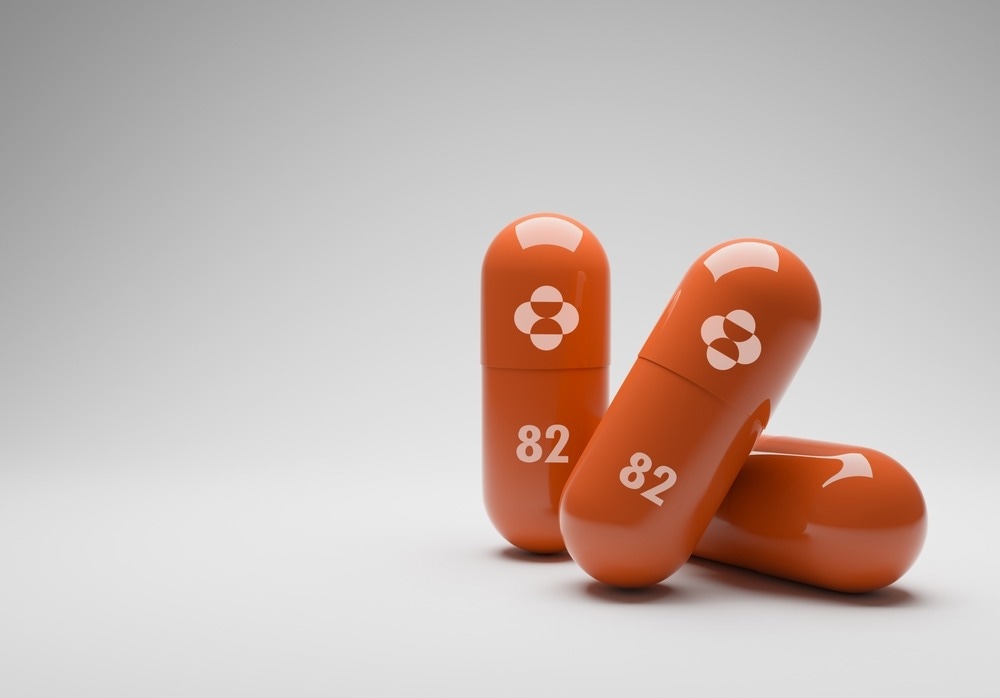Since the onset of the coronavirus disease 2019 (COVID-19) pandemic caused by the severe acute respiratory syndrome coronavirus 2 (SARS-CoV-2), over 6.38 million deaths and 572 million infections have been reported.
Due to genomic mutations, many SARS-CoV-2 variants have emerged with varied virulence and transmission rates as compared to the ancestral SARS-CoV-2 strain. These variants have been classified as variants of concern (VOC) and variants of interest (VOI) by the World Health Organization (WHO). At present, the SARS-CoV-2 Omicron (B.1.1.529) variant is the dominant circulating strain in most countries around the world. This variant appears to have a short incubation period of two to 11 days.

Study: Safety and efficacy of molnupiravir in SARS-CoV-2 infected patients: a real-life experience. Image Credit: Quality Stock Arts / Shutterstock.com
Background
Some of the common symptoms associated with COVID-19 include cough, fever, gastrointestinal disorders, dyspnea, headache, as well as loss of smell and taste. In some cases, individuals who experience severe COVID-19 may suffer life-threatening systemic inflammation, multiorgan dysfunction, and respiratory failure.
Various pharmaceutical and non-pharmaceutical strategies have been developed to combat COVID-19. In terms of pharmaceutical approaches, several vaccines and therapeutics have been developed and have subsequently received approval from global regulatory bodies, such as the United States Food and Drug Administration (FDA).
Previous in vitro and in vivo studies have shown that molnupiravir, which is a ribonucleoside prodrug of N-hydroxycytidine (NHC), is effective against SARS-COV-2. Molnupiravir, which targets the ribonucleic acid (RNA)-dependent RNA polymerase (RdRp) of SARS-CoV-2, is associated with a superior safety profile.
One of the key advantages of molnupiravir for the treatment of COVID-19 is that it can be easily administered at home. Other COVID-19 therapeutics, such as monoclonal antibodies and remdesivir, require hospital settings to be administered.
Phase II clinical studies have determined the most effective dose of molnupiravir to be 800 mg every 12 hours for five days. However, there remains a lack of real-life data confirming the efficacy of molnupiravir in treating COVID-19.
About the study
In a recent retrospective Journal of Medical Virology study, researchers report the efficacy and safety of molnupiravir in a real-life setting.
The study cohort included adult participants diagnosed with COVID-19, which was confirmed by the reverse transcription-polymerase chain reaction (RT-PCR) assay. These patients were subjected to a five-day treatment course with molnupiravir according to the Italian Agency for Drugs guidelines.
Symptomatic COVID-19 patients who did not require oxygen supplementation and were not at risk of developing severe symptoms due to the presence of comorbidities were prescribed molnupiravir. The medical history, blood test results, and other relevant documents were reported for all study participants, regardless of disease progression. Furthermore, the researchers calculated the Charlson Comorbidity Index (CCI) score and 4C-score for the study cohort.
Study findings
The current study included 192 people whose mean age was 70.4 years. In the study cohort, 144 patients were above 40 years of age.
During follow-up, 10.4% of participants exhibited disease progression. Notably, neurodegenerative disorders were associated with an increased risk of COVID-19 progression.
Multivariate analysis revealed older age individuals with neurological disease who exhibited dyspnea at the onset of symptoms and acquired COVID-19 during a hospital stay for another health condition were associated with an increased risk of disease progression.
Importantly, molnupiravir was found to be effective in older people who were not vaccinated against COVID-19. The early initiation of molnupiravir therapy was associated with a reduced risk of disease progression. Importantly, 6.8% of the study cohort exhibited adverse effects of the drug, thus confirming the overall safety of this treatment.
Conclusions
The current study highlights the effectiveness and safety of molnupiravir in a real-life setting, particularly among an elderly population with a high incidence of comorbidities.
Some limitations of the current study include its observational and retrospective approach. Further, the cohort does not represent an international situation. CT scans and blood tests were also not acquired for the entire study cohort.
In the future, more studies are needed to determine the optimal timing to start molnupiravir treatment in COVID-19 patients.
Journal reference:
- De Vito, A., Colpani, A., Bitti, A., et al. (2022). Safety and efficacy of molnupiravir in SARS-CoV-2 infected patients: a real-life experience. Journal of Medical Virology. doi:10.1002/jmv.28011.